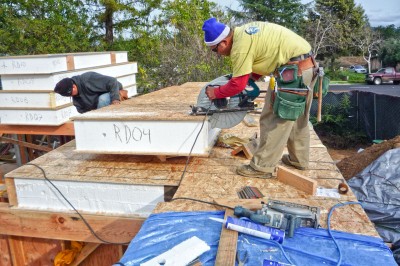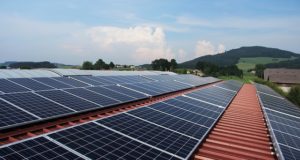
image credit gabreport.com
What if we had a revolution and nobody came?
This is a question that companies selling structural insulated panels, or SIPs, must be asking themselves every day. Here we have a building product that has in fact radically revolutionized residential construction procedures, and yet hardly anyone knows anything about it. And we are not just talking about people building new homes here, but even most builders have probably never worked with structural insulated panels and know little about their qualities.
Make no mistake: in the world of home construction, SIPs are the rainbow trout in a stream filled with carp, outshining and outperforming the competition in virtually every aspect, most importantly in the area of energy-efficiency. The typical stick framed wood home is like a sieve to the flow of air, and even with layers of insulation added, it is still highly effective at transferring heat in the wrong direction. But a home constructed from structural insulated panels is as airtight as they come, and any person committed to significantly lowering his level of energy consumption couldn’t possibly find a better alternative to SIPs should he decide to build a new home or undertake a comprehensive renovation on an old one.
“Hold on there, pardner,” you’re probably saying. “Structural insulated panels? What the heck are they and what is it that makes them so special?” Or maybe you have heard a little bit about SIPs already, but are only obliquely aware of the qualities they possess and are curious to learn more. Certainly the chances are excellent that you fall into one of these two categories – completely uninformed or only tangentially so – because if the reality were different, SIPs would be locking down a whole lot more than just 1 to 2 percent of the new home construction action.
This paltry statistic is a crying shame and a bit of a mystery given the undeniable excellence of SIPs, and it represents perhaps the best example of untapped potential you are likely to find anywhere this side of the dormant US space program. And one thing we can say for sure is this: if you are someone interested in making a permanent leap off the grid, the art of SIP home building and renovation is eminently worthy of investigation. Successful off-the-griddism is all about doing more with less or just plain doing with less, and SIPs are the invention of minds that are entirely in synch with yours.
150 Ways to Cut Your Energy Bills Now…
But we still haven’t answered that all-important two-part question yet, have we? What are structural insulated panels, and what is it that makes them so great? Enquiring minds want to know, and if you are one of them, please read on.
Long Live The King Of Off-the-Grid Building Materials!
It may be surprising considering how little publicity they have received, but structural insulated panels first began to be used in residential construction back in the 1970s, primarily in the northeast United States. The idea behind them is ingeniously simple: take a slab of rigid foam insulation, sandwich it between two solid pieces of construction-quality wood facing, secure the insulation to the facing with glue, mechanical fasteners, or high-pressure bonding to create one entire assembly, and voilà! there you have it: a strong, durable, and leak-resistant building panel that can be combined with other such panels to fabricate a structure that will be as airtight as a sealed vacuum tube. Grooves, channels, and splines on the edges of each SIP will allow the various panels cut for a particular home to be fitted together as easily as a kid’s Lincoln Logs, although staples, nails, screws, or mechanical fasteners will usually be required to fix the various panels together more firmly. It will also be necessary to seal all joints between SIPs with specially-prepared sealing mastic, expanding foam sealant, or self-adhesive SIP tape to guarantee the newly-formed edifice will be truly resistant to air leaks.
Most SIPs are manufactured using two sheets of 7/16 inch oriented strand board (OSB) and a rigid foam insulation insert made from expanded polystyrene, a type of closed-cell lightweight plastic that is 2 percent carbon and hydrogen and 98 percent air. Alternatives are available, including plywood, steel, cement board, and sheet metal for the sheathing and extruded polystyrene plastic (which is actually superior to expanded polystyrene but more expensive) for the insulation, but OSB is used in more than 90 percent of all the SIPs currently available on the market. These materials are relatively cheap to produce and contain no toxic chemicals of any type, but when they are combined in one super-tight assembly they form a building block that has the strength of a steel I-beam, making them strong enough to handle earthquakes, floods, hurricanes, and a heavier compression load than the wood panels used in conventional stick frame construction.
Rough and tough and strong enough to be used in walls, floors, foundations, and roofs, structural insulated panels are manufactured in factory-controlled conditions and can be customized in size and shape to fit the requirements of any building plan. While a typical 4’x8’ panel can be easily maneuvered into place by two men, larger SIPs in the 12’x24’ range must be elevated and set into place by forklift or crane. The thickness of the panels ordered will generally fall somewhere between 4 and 12 inches, depending on the amount of strength needed to provide adequate support and the amount of insulating ability that is desired on a particular building project.
More than anything, structural insulated panels represent the triumph of simplicity over complexity. SIPs combine the functions of studs, joists, conventional wood panels, insulation, and moisture and air vapors all in one formidable package, and this functional versatility gives them an unbeatable advantage over the motley collection of materials that are still being used to construct the vast majority of the new homes that are being built in the US and across the rest of the world.
Yes, news of the revolution has indeed been slow to spread.
The Costs Versus The Benefits: It’s a First-Round Knockout!
But that old bromide about something that “seems too good to be true” must apply somewhere here, you’re probably thinking; and in fact, SIPs do have a downside that helps explain why they have not caught on despite their inherent superiority over other types of structural building materials.
If you don’t know already, you could probably guess. Naturally, it is all about cost: structural insulated panels are up to 20 percent more expensive than standard building materials by the square foot, and obviously this scares many people away right from the outset. But this navel-gazing approach to home construction is just the sort of thing that off-the-gridders have learned to reject; when you have dedicated your existence to living as efficiently as possible in every meaningful measure, you learn that the size of your investments is far less important than their long-term payoff. And in that important place where the rubber meets the road, structural insulated panels can really deliver the goods: over the course of its existence the total life-cycle cost of a home built entirely from SIPs can be as much as 40 percent less than a home built with more traditional materials.
To start with, much of the extra cost of SIPs will be offset by a reduced labor costs during the actual construction process. Greater simplicity means streamlined building practices, and because SIPs come fully prefabricated, it takes fewer workers less time to put together all the interlocking pieces of puzzle that will eventually become a fabulous new home. Construction cost analysts at an independent company called R.S. Means carried out a systematic study of SIP building techniques and concluded that a well-trained SIP installation crew could cut down on framing time by as much as 55 percent in comparison to a similarly trained group erecting a conventional stick frame structure.
When reduced labor costs are factored in, SIP boosters claim the cost of putting up an exclusively SIP home is very comparable if not equal to the cost of building something the old-fashioned way. We suspect this is a bit optimistic, but there is no question that labor investments are less significant with SIP construction. Sometimes, depending on how customized a buyer wants his new home to be, the design costs can be noticeably greater than would normally be the case, but this hidden cost can be avoided if exotic schemes are eschewed.
SIPs also allow the homebuilder to eliminate certain financial commitments by cutting down on the sheer quantity of materials that must be ordered and installed. There is of course no need for separate insulation, as well as a drastically reduced need for supporting studs or joists (depending on the design of the home, a 50 to 75 percent reduction is likely). Also, because of the sophisticated and customized nature of SIP manufacture and installation, construction site waste can be cut down to a meager percentage of the normal – the National Association of Home Builders estimates that 7,000 pounds of waste are produced during the building of a 2,000 square foot home by traditional methods, which is a lot of stuff being paid for that is not actually being used. Up and down the line from design to fabrication to installation, SIPs are big-time efficiency promoters, and there are a lot of cost savings being passed along in hidden ways that won’t be apparent without a closer examination.
And speaking of big-time efficiency promotion, it is in their phenomenal ability to regulate the flow of heat and air that structural insulated panels gain their most extraordinary advantages. As you probably already know, the ability of insulation to insulate is measured by a statistic called R-value, which rates a material’s resistance to heat transfer. The higher the R-value, the better, and SIPs are able to achieve R-values of approximately 14 for every 4 to 4.5 inches of thickness (this is if expanded polystyrene is used; extruded polystyrene performance is about 50 percent better). This is more than enough to get the job done in any geographical location, but because the insulation in an SIP structure is continuous with no breaks, its functioning is not compromised in the same way as normal types of insulation that are installed around and between materials that undercut their performance. To put things in perspective, the Oak Ridge National Laboratory tested a 4-inch thick SIP wall with a R-14 rating and proved that it could outperform a 2’x6’ stick framed wall filled with fiberglass batt insulation rated at R-19.
But it gets better. Further Oak Ridge National Laboratory testing found that rooms in an SIP home are 15 times more airtight than rooms in a typical stick framed wood home, and since 40 percent of the heat loss a building experiences comes about as a result of air leakage, this figure is highly significant. Because airflow is almost non-existent in an SIP home, it will be necessary to install a system that ventilates interior spaces mechanically; this is actually a good thing, however, because an air control system combined with a dehumidifier can filter out allergens and other pollutants and eliminate mold and mildew by keeping moisture entirely out of the home. So in addition to their other advantages, SIP homes can actually promote improvements in their inhabitants’ health.
Let’s get to the bottom line: just how much energy can a family living in an SIP home expect to save from a reduced need for heating in the winter and cooling in the summer? Results will of course vary, but if a home made from SIPs has been properly constructed, yearly heating and energy savings of between 30 and 40 percent are achievable; and if passive solar design principles are incorporated and materials with high thermal mass are used on the interior of the home, a SIP home could conceivably surpass the 50 percent improved energy efficiency mark in comparison to the average American residence. Needless to say, with numbers like this, it is not hard to understand why the total life-cycle numbers for SIP homes are so impressive.
Brand New Way To Generate Your Own Perfect Power…
The Revolution Will Be Televised
Not convinced yet that SIPs really are the cat’s meow? Here are a few more of their excellent characteristics that may help persuade you:
- SIPs have exceptional strength – structural insulated panels are so firm and rigid that pieces with spans as long as 18 feet can be used on roofs with no additional support.
- SIPs are highly sound resistant – living inside of a SIP home can feel like being in a sound-proof booth, and they do an especially good job of filtering out high frequency noises.
- SIPs have natural vapor and air protection abilities – since their solid continuous form eliminates the wall cavities that unwanted air and moisture can exploit so easily, unlike other building materials, SIP walls require no additional vapor or air barriers.
- SIPs are easily modified – despite the fact they are generally manufactured to form before being shipped by truck to the construction location, SIPs can be readily modified onsite as needed with a few special tools such as a beam saw, a circular saw with an added cutting attachment, or a hot wire foam scooper (SIP manufacturers can fill you in on the details).
- SIPs are customized for easy electrical wire installation – SIP contain precut tunnels called chases that run vertically and horizontally and allow for quick and convenient wiring without the need for additional drilling.
- SIPs are pest-resistant – termites don’t eat SIP insulation, and to keep insects of all types away is it possible to purchase SIPs with borate-treated polystyrene or a specially designed steel mesh installed in the interior.
- SIPs are compatible with other types of building materials – anyone who is afraid they can’t afford to build an entire home from SIPs, or who only wants to renovate an existing home, can easily combine these panels with traditional building materials such as dimensional lumber used on stick frames, poured concrete, or insulating concrete forms to create fully functional and highly energy-efficient hybrids.
If there is any bad news at all about structural insulated panels it is that there are not that many builders familiar with them. In fact, many will refuse to work with SIPs because they are just flat-out intimidated by building techniques and materials that seem so strange from their limited perspectives. Old habits do undoubtedly die hard, and unfortunately many builders would prefer to follow the path of least resistance rather than experimenting with a construction style that could potentially re-energize the dormant housing industry.
Nevertheless, there are a number of fully qualified SIP builders out there eagerly looking for work, and if you consult the Structural Insulated Panel Association (SIPA) membership directory, you will be able to find any who might be operating in your area. At this point in time most SIP construction has been taking place in the east, so if you are in the western United States, finding a good builder might be a little more challenging. But learning SIP construction techniques is not difficult, so if enough people begin asking their local builders about SIPs, it may motivate them to begin earnestly exploring the possibilities for good profit offered by these fantastic home building products.
In reality the SIP revolution is still in its nascent stages, so it is definitely not too late for efficiency-minded off-the-gridders (are there any other kind?) and adventurous builders to put aside their preconceived notions and get in on the fun.
 Off The Grid News Better Ideas For Off The Grid Living
Off The Grid News Better Ideas For Off The Grid Living




